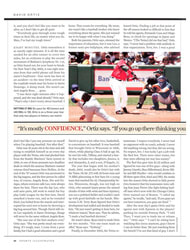
Se Ri Pak's Fresh Start
Se Ri Pak had won22 times on the LPGA tour, including four majors, but she'd never jumped forjoy on a golf course. By her own admission, she'd never done much of anythingon a golf course that smacked of joy or even fun. But on Sunday it became clearthat much had changed when, on the first sudden-death hole of the McDonald'sLPGA Championship in Havre de Grace, Md., the rejuvenated Pak leaped into hercaddie T.J. Jones's arms after hitting a hybrid club 201 yards. Pak's shotskirted the water guarding the 18th green and stopped within four inches of thecup, leaving her a tap-in birdie. Walking on air, the 28-year-old Pak brokeinto a grin that few had ever seen from her on a course. The grande dame ofKorean golf was back.
No one felt thatmore keenly than the victim of Pak's heroics, Karrie Webb, another resurgentveteran who had shot a four-under 68 on Sunday to get into the playoff withPak. Winless last season, the 31-year-old Webb was trying to take her secondmajor championship of 2006 after going four years without one. But Webb, freshout of miracle shots, was unable to match Pak's birdie on that first extrahole. "I was getting a taste of my own medicine," Webb said, referringto her own jump-for-joy moment, the full wedge that went in for an eagle at the72nd hole of this year's Kraft Nabisco Championship. "I'm really happy forSe Ri. After I won Kraft, she gave me a hug and said it was good to see meplaying well and that now it was her turn, she'd win the next one. And then shewent and did it."
Along with AnnikaSorenstam, who tied for ninth at the McDonald's, Webb and Pak dominated women'sgolf in the late 1990s, a point driven home last Saturday when the Hall of Fametrio, which has 122 wins and 21 majors among them, played together in the thirdround. But for all the attention that historic grouping stole from theballyhooed young guns of the LPGA, especially a certain winless 16-year-old,you'd have thought that they were named Winken, Blinken and Nod.
It's MichelleWie's world now, and the rest of us are just living in it. Wie, who finishedsecond in this tournament in 2005, last week tied for fifth, two shots out ofthe playoff. It was her fifth top five finish in 10 starts in the majors, butshe garnered most of the headlines and attracted the largest crowds, and hadshe putted only tolerably well, she could've won by six or seven shots. Howsuperior was Wie's ball striking? She ranked first in greens in regulation(80.56%) and was the only player to reach the 596-yard 11th in two. But she wasa fearful 139th in putting, taking a staggering 126 putts over four rounds.
Wie's struggleswith the flat stick actually came to the fore on the Monday of McDonald's week,when her attempt to become the first woman to qualify for the U.S. Open wasderailed by the 35 putts she needed on her second 18, a round in which she shota three-over 75. Wie missed qualifying for Winged Foot by five strokes, andnearly all of them could be accounted for on the greens.
That trendcontinued in the opening round at Bulle Rock, a 6,596-yard Pete Dye design withsubtle undulations on the greens that repeatedly fooled Wie. Since October, ina laudable effort to become self-reliant, she has been reading putts withoutthe help of her caddie, Greg Johnston. Last Thursday, Wie missed six putts of12 feet or less over the first eight holes. "I was ready to yank my hairout," she said. "I felt as if I played really well but couldn't getanything going."
Wie salvaged theround by birdieing three of her last four holes for a respectable 71, but on awindless day when Nicole Castrale set the course record of 64, it wasn't anideal start. Teeing off early on Friday, when the course was soft and the aircalm, Wie built on her momentum, shooting 68 before a thunderstorm blew in anddelayed play for most of the field for five hours. She still needed 30 putts,however, and could easily have gone three or four shots lower.
David Leadbetter,Wie's coach, defended her putting stroke, saying that Wie's woes were theresult of switching from the bermuda grass she plays on at home in Hawaii,where Wie recently finished her junior year at Honolulu's Punahou School, tothe bentgrass of the East. "Even on the PGA Tour players struggle goingfrom West to East," Leadbetter said. "Her putting stroke is way betterthan last year. It's more rhythmic. She has learned to control the speed betteron lag putts. Under pressure that stroke gets a little slower and moredeliberate, and she stands over the ball longer." Leadbetter would like Wieto pull the trigger in about eight seconds; longer than that and too muchtension builds in her arms. But his charge, said Leadbetter, "has workedvery hard with my wife, Kelly, on developing a consistent routine." Intruth, Wie has two putting routines. From 12 feet and in, which is where shehas the most problems, she steps up to the ball, peeks at the hole twice andputts without taking any practice strokes. Beyond 12 feet, Wie takes a coupleof practice strokes to get the feel for distance.
Nothing she triedseemed to work on Sunday, when Wie torpedoed her chances for her first pro winby taking 35 putts--including a lip-out of a four-footer on 16 that stopped herclosing charge (BIG PLAY, page G18)--while shooting a 72. Wie averaged threemore putts a round than Pak. "I felt as if I hit every single putt where Iwanted to," Wie said. "I felt as if every putt was going to goin."
Wie's day willcome, but for Pak, who won her first LPGA Championship at age 20 in 1998, thefear was that her day had come and gone. That year Pak also won the U.S.Women's Open. One of only two South Koreans on the tour at that time, shebecame an overnight icon in Korea, inspiring a generation of young girls totake up the game. (Thirty-two Koreans are now playing on the LPGA tour.) Buttheir matriarch became a walking cautionary tale as her early success wasfollowed by intense loneliness and burnout. When she wasn't playing golf orpracticing golf, she was thinking about golf. Her body breaking down, hercompetitive spirit crushed, Pak last year came to a glum realization: "Ihated golf," she says.
At the Women'sBritish Open last July, while hacking out of the rough, she hurt the middlefinger on her left hand--an injury that she now regards as a blessing from God."I couldn't play," Pak says. "My doctor said I couldn't even toucha club. It was such a relief. For the first time in my life I could simplyrest."
She returned toher hometown of Daejeon, an industrial city 100 miles south of Seoul, and spentthe better part of the fall taking long hikes in the mountains with her family.She stayed out late at night with friends, talking and carrying on like acare-free twentysomething.
"I neverrealized that I have so many friends," Pak says. "Or maybe I simplytotally forgot about them. Why did I spend so many years thinking I waslonely?" She even took up photography, her first hobby. "None of it wasreally a big deal," she says. "It was normal life. But for me I havenever had that. I was too busy practicing."
The break alsogave her a chance to escape from Sorenstam's towering shadow. It wasSorenstam's relentless excellence that had helped drive Pak to the brink. In2001 Pak won five times and earned $1.6 million, but Sorenstam banked $2.1million with eight victories. In '02 Pak was even better, with another fivewins, but her achievements barely registered as Sorenstam won 11tournaments.
"Every singleround I was thinking about her," Pak says. "I won so many times, but Icould never be Number 1. No matter how hard I worked or how well I played, oneperson would not stop. It got to the point where I didn't want to see her. Icouldn't get rid of her! It was always second, second, second. I was so sick ofit, so sick of her. I was trying harder and harder to play perfect golf. I keptpushing myself, but that can't go on forever. I'm a human being, you know, nota machine."
This off-season,with so much time to reflect, Pak finally made peace with the very idea ofSorenstam. "Now when I see her, I tell myself I can do better," Paksays. "I recognize she's a great person in history. She inspiresme."
On Sunday, withone gutsy swing and a joyous leap, it was Pak's turn to inspire.
"It got to the point where I didn't want to see[Annika]," Pak says. "I couldn't get rid of her! I WAS SO SICK OF IT,SO SICK OF HER."
THREE PHOTOS
CHUCK SOLOMON (3)
KNOCKOUT BLOW In the playoff Pak put her 201-yard approach four inches from the hole.
PHOTO
CHUCK SOLOMON
WEAK LINK Despite taking three more putts a round than Pak, Wie contended until the end and finished in a tie for fifth.

